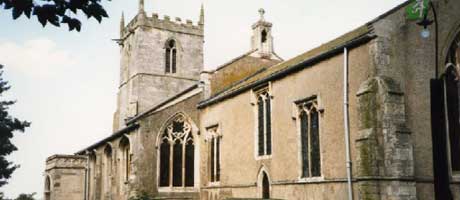Owston Ferry (Ostone)
The parish of Owston forms the south-east part of the Isle of Axholme, and extends along the bank of the river Trent, the river forming its eastern boundary. It comprises Owston, West Ferry, Gunthorpe, Heckdyke and Melwood. Topographically, the land is mixed, the soil next to the river being rich and fertile but changing on the higher ground to strong clay. Most of the low grounds in this parish have been improved by the process of warping.
The parish church, situate at the western end of the village of Owston Ferry, is dedicated to St. Martin and contains much of interest to the family historian, not least are those tombs therein of local gentry, the family containing most being that of Pindar, prominent in the Isle since the mid-sixteenth century.
Until their reported removaL to Burton upon Stather the remains of several members of the illustrious family of Sheffield were here interred. The Sheffields occupied a large estate within this parish and it was Sir Robert Sheffield who built a castle at neighbouring West Butterwick, then a part of this parish, in the late 15th century.
A most valuable record; totalling three volumes, of the Baptisms, Marriages, and Deaths for this Church are available for consultation at Lincoln Record Office, the Castle, Lincoln. These indexed recordings are known as the Brace Transcripts and cover a period from 1599-1812. On the south side of the Church can be seen the mound on which stood in former times the keep of a "motte and bailey" castle, said to have been built shortly after the Conquest and held at one time by the powerful Mowbray famiLy. It was taken by Geoffrey, Bishop elect of Lincoln, in 1174, on behalf of Henry the Second and was later destroyed and never after rebuilt. This particular site is known locaLly as Kinniard's Castle, from the original place name.
Until the early 1940's the village ferry was in constant use, Bob Royston being the last ferryman, a position he held for twenty six years, beginning with a weekly wage of thirty shillings. His weekly accounts revealed he charged his passengers 2d. for the return crossing and had on average eighteen passengers who paid weekly. Among those who have manned the ferryboat during its long history are Alfred Torn, Tomay Batty, Tommy Mathers, and Arthur Pettit.
The famous tidal bore known locally as the "Aegir" is seen to good effect from the banks of the Trent at Owston Ferry. Such a natural phenomenon never fails to excite the seasoned spectator as well as the first time witness and can seen at its best in early Spring and late Autumn.
Low Melwood in this parish is the site of a Carthusian monastery, founded during the reign of Richard the Second. Very little remains of its existence but the moat which encircled the building is still evident and can be viewed from the roadway on the approach to Epworth. Darcy Stanhope, another of the parish gentry, resided at nearby High Melwood during the 17th century when this place was comprised of large acres of parkland. The Stanhopes of High Melwood were descended from Sir Michael Stanhope, himself a descendant of a significant Nottinghamshire family.
The benevolent Miss Frances Sandars, born in 1787, is well remembered in the village of Owston Ferry for her many gifts to the village. In 1860 she founded, "for the benefit of aged females" six almshouses, each resident receiving an "allowance for daily bread" totalling five shillings per week. Frances Sandars also provided at her own expense the parish clock, mounted on the old school building, and left various bequests to the Church, the school, and the poor at Christmas.
The present Primary School on Burnham Road, built in 1966, was dedicated "St. Martin's Church of England School" by the Lord Bishop of Lincoln, the Rt. Rev. Kenneth Riches, D.D., and the official opening was performed by Sister Marguerite O.H.P. on September 19th, 1967. The old school, situate on high Street, has now been converted into a private residence but still retains much of its original architecture.
Owston Ferry, today, is a quiet village having long relinquished its river trade links with the ports of Gainsborough and Hull. A few of the warehouses still survive on Trentside but are no longer used for waterway business. Many of the present populace are involved in agriculture and until recently still possessed a village blacksmith, in Mr. George Lamming, George being the last in a line of family blacksmiths up until his death earlier this year, so breaking a long-held tradition within Owston Ferry. Quite a large number of the present community are descended from families of long-time standing in Owston Ferry and the immediate area with such names as Anderson, Clark, Clayphan, Duffield, Fletcher, Holmes, Leggott, Lindley, Smithson, Temperton and Jervis.
It is of no small interest that whilst the locals pronounce the name of this village "O"wston (Ferry), most newcomers to the district are easily identified by their own pronunciation of this place, "HOW"ston (Ferry).

